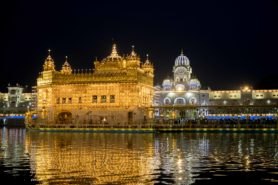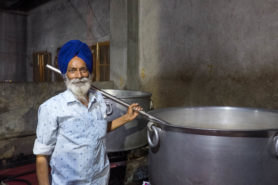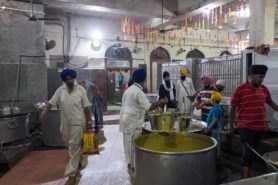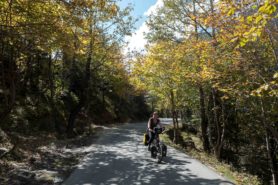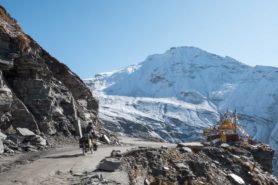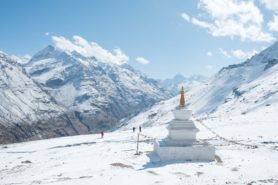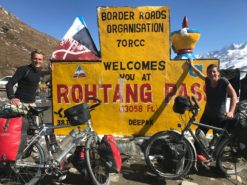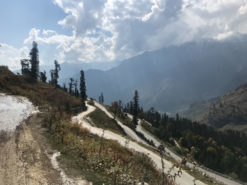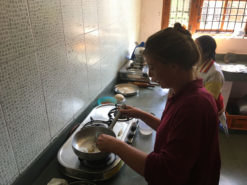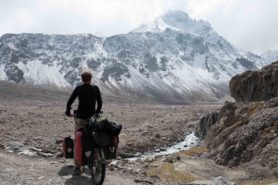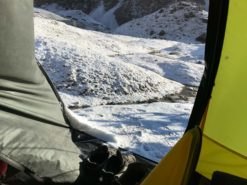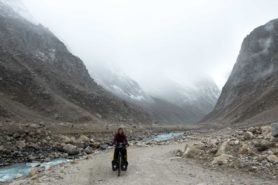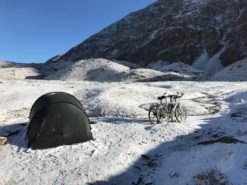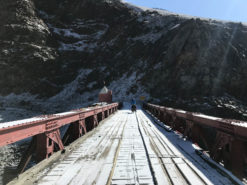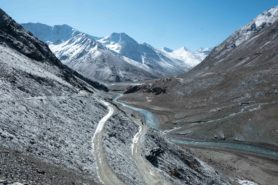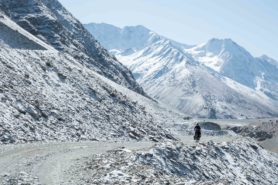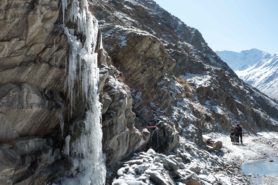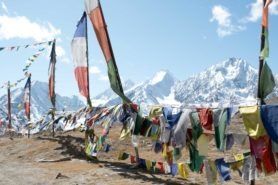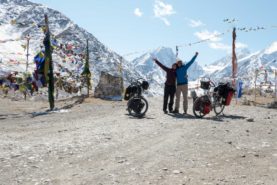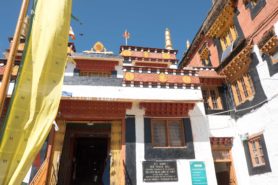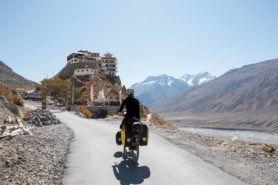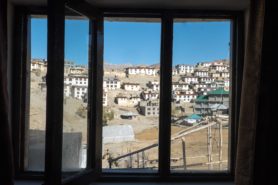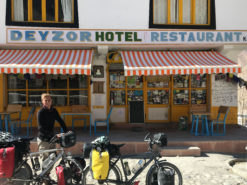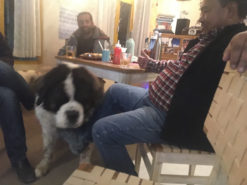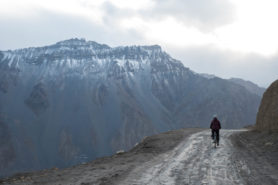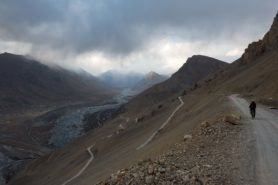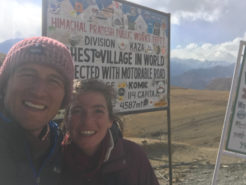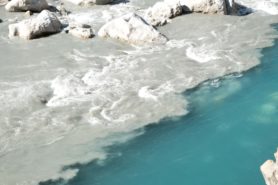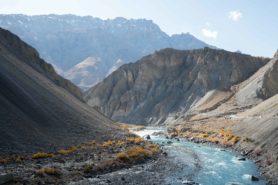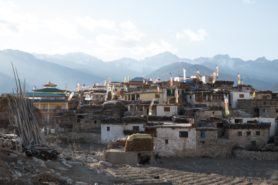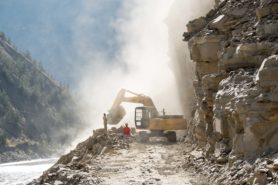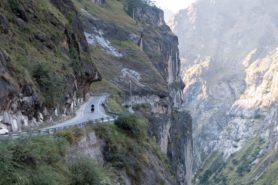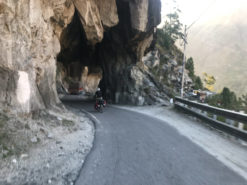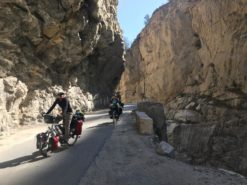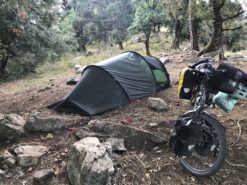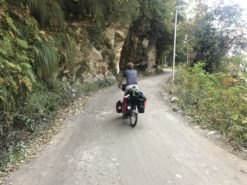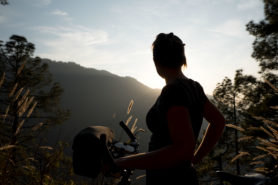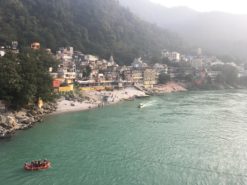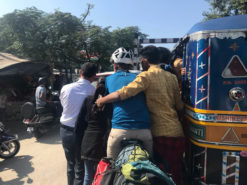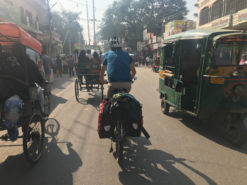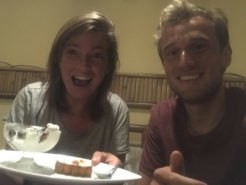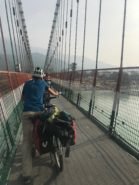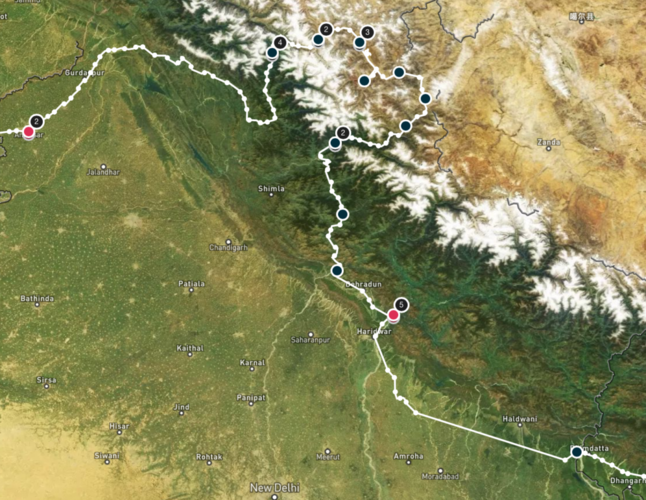Amritsar (IN) – Banbasa (IN) / 12280 km / 5.9 Million Turns / October 13th – November 6th, 2019
A few times already on this trip, we returned to places already visited before, but now on the bike. So was the same for Amritsar, India. After leaving Lahore and making our way across the plains of Punjab, we could already see in the distance two towering flag posts waving side-by-side, or rather, head-to-head. The countries were making sure their flag was at least as big as the other one, making both of them gigantic in the process. We arrived at the border town of Wagah, famous for being the only border open between the rivalling nations of India and Pakistan. Considering the level of tension between the two countries, especially in the period when we crossed (India had just revoked the special status of Kashmir, to the anger of Pakistanis), it went all surprisingly smooth. Even our drone got through unnoticed, although this did give some sweaty moments as we officially had to report it. Sorry, forgot that, dear customs people.
We spent the evening in Amritsar, which as stated was not new to us. The main draw of the city, the magnificent Golden Temple of the Sikhs, was still gleaming bright as before. What was new to us however, was how incredibly noisy this city was. Or maybe we just grew older and more sensitive to noise. Tom even came up with his new favourite word: cacophony. It was tough on the senses being in this city and we had a hard time adjusting. Every single car would blow the horn at least every 10 seconds. Each bus racing through the city would blow it all the time, in an effort not to hit anyone. And then we haven’t even mentioned the rikshaw drivers… Welcome to India, the pressure cooker country which in each and every aspect of life is louder, noisier and busier than any other place on this planet. Escaping the city helped and from Amritsar we took a night bus to Manali, at the foothills of the Indian Himalayas, where we would start cycling again.
The main draw of going to India was Spiti valley, a region in the far north, one road in and one road out, with passes to cross that reach an altitude of 4500 m. It is often described as a ‘world within a world’ as it is so remote and has historically been as such separated from the rest of India. The region is culturally closer to Tibet than Hindu India. In fact, since Tibet has been closed off and culturally repressed by the Chinese, some say Tibetan culture is more alive in Indian areas such as Spiti than in Tibet itself. We were excited to see it for ourselves and hoped we would still be in time before the high passes were snowed in and closed for the winter. It were exactly these passes we were facing now that made us take busses already as far back as Turkey, just to be here preferably by the end of September. In practice, we arrived belatedly in mid-October. However, after asking local agents it seemed the passes were still open fortunately, although many warned us it would be cold, snowy and many places for food and shelter along the way would be closed already.
We were a little nervous naturally, as it was not fully without risk. We also knew however that we had quality gear, enough food to last double the time we planned to be in the high areas and studied the road ahead in detail. And so, after a final few days of preparation and groceries we set off. In our T-shirts, as still in the warm valley, we headed to the first of two passes the cross: the Rohtang Pass. After an entire day of switchbacks up, we were no longer in the warm and lush valley though but at a cold and treeless 3500 m altitude settlement. Here it started raining heavily, quickly turning into snow through the evening. We found shelter at a small guesthouse below the pass, where during the evening several soaking wet motorcyclists poured in, fingers so cold and numb they had to stand at the gas stove to heat them up (there was no real heating anywhere in the settlement). So that was what we could expect too….. “Hope the weather clears in the morning”, we said, fingers crossed.
The next morning though, the weather was beautiful again, with a carpet of crackling white snow next to the cleared road. The last few metres up to the pass itself were captivatingly beautiful, the air so crisp blue and the snow so virgin white, with a black road winding itself along Tibetan stupas up to the top at nearly 4000 m. The buses and us speeding up in Turkey, Iran and Pakistan were not for no reason we saw now and with a big smile on our face we crossed the Rohtang pass.
Descending from the pass, we were now in the Lahaul district, the area which we had been fearing a little. This was an area where not many people lived as it is behind the Rohtang pass but before a second, even higher pass, Kunzum La. As such, it is cut off from the rest of the world in all directions. Actually, we saw just two inhabitants in a stretch of a 100 km. Since it was so late in the season, all settlers had already moved to warmer areas, leaving all guesthouses and restaurants locked and closed for the winter. To get through, we camped twice, with the second night being one of the coldest of the trip (and also most memorable). We had to cook with 5 layers of clothing on to fight the freezing winds, and at night heard fresh snow fall on the tent. In the morning, even Sabine’s contact lens fluid was frozen solid, which was inside the inner tent. We were happy the sun got through a few hours after we were awake, and could set off to climb the Kunzum La, the final barrier before reaching Spiti valley itself.
The climb, along a gravel road with icefalls on one sides and steep drops on the other, went up to 4550 m; we hadn’t been as high as this since the Pamirs, but the backdrop of snow-capped mountains and the bitter cold on the top of the pass made this pass feel a lot higher than the 4650m Ak-Baital pass in Tajikistan. To our surprise, the climb itself was more doable than the Ak-Baital pass, probably due to the absence of fierce headwinds. The top was lined with prayer flags and stupas, as a greeting for new visitors entering Spiti and to act as safeguard for all travellers crossing the pass. As on Rohtang La we cycled with awe and mouth wide open from the beauty of this place. It made us wonder how right and wrong you can be about India when you want to describe it. Yes, like Amritsar it can be noisy, dusty and feel like a pressure cooker, but then again, this quiet serene pass with nothing but mountains around you also is India…
We had now ‘conquered’ both passes and slowly descended into Spiti Valley below us. As in Lahaul, many guesthouses were already closed and some people had left, but the quietness of the place actually made it a lot nicer cycling. In peak season it’s a very popular destination for mostly Indian tourists, so the lack of crowds was much more valuable than the not-so-warm temperatures. We cycled to the main town of Kaza via Kibber, a place we heard was famous for spotting snow leopards. We didn’t spot one, and even if they had been in our field of vision, they are so well camouflaged you probably look straight over it. Still, it was a cool feeling to be so close to these elusive animals. Along the way, we visited Key Gompa, a Tibetan monastery perched high up a cliff like an eagle’s nest. Still active today, the monastery houses about 300 monks. We learned from one of them that according to Spitian traditions, every eldest son becomes a farmer, and every second son a monk. No choice, that is how life is structured. It was of course difficult to truly find out if the monk liked his predestined profession, although we did ask him. He stated his life in the monastery was a lot simpler. No family, no friends, but all the time in the world for reading and meditation which helped his mind reach a higher stage of enlightenment.
Via Warmshowers, the cycling hosting platform, we wrote to Karan, who runs a small hotel in Kaza and is active here. As there’s almost no cellular reception and hardly any internet in the area, he hadn’t read our message, but when seeing our bikes he understood immediately. Of course, nearly all Warmshowers hosts are nice, mostly since you both have a common understanding of what cycle touring is about. It doesn’t really matter if you get offered a couch or empty shack to put your tent. But, Karan’s hotel was a delight one cannot deny. Thick matrasses, thoughtfully designed rooms, homemade cookies and best of all, hot water bottles to warm yourselves before going into bed (there is no such thing as central heating in Spiti except for a fireplace). Ok, these materialistic things are unquestionably very nice, especially after the cold nights we had had just before, but it was mostly Karan’s look at life and the way he had positioned his hotel in the community that were remarkable and inspiring. He was running awareness campaigns to limit the use of plastic, promoting the use of barley (which grows natively in the valley in contrast to imported rice), letting tourism be more low-key, and in general, made a small bubble for people to come and reflect upon life, without much internet (his WiFi password: havepatience) or other distractions of ‘life outside the valley’. Together with his 72 kg St. Bernard dog called Simba and six of his adopted dog brothers and sisters, he has made a very special place in Kaza, which we will remember for a long time.
In Kaza, we also met up again with Pavel and Zanna, the Polish couple we met in Pakistan and who were now also cycling here. During the entire course of our trip, we said hello and goodbye about 6 times, crossing each other, cycling together for a few days, splitting up since both had slightly different plans always, but bumping into each other again, often by sheer coincidence. It was good to have some extra cycling buddies when going up the steep climbs out of Spiti Valley.
Spiti valley was nearing to an end; one final climb to the village of Nako, from where you could actually see the border with Tibet, and then a big downhill ride into the next district, Kinnaur. This area no longer was Buddhist/Tibetan in culture but “Indian” (whatever that meant after having seen so many aspects of India). It was sort of middle ground between the high-altitude desert of Spiti and the lowland plains a few hundred kilometres south. Wild rivers were raging through canyons, and the road frequently was cut straight into the side of the cliff. “Beware of shooting stones”, many signs read, with the instructions on how to avoid getting hit by one. “Stop. Look up. Go” (or not go if a stone happens to fall). We were shown how serious these warnings were when a giant landslide happened just hours before we arrived and had blocked about 200 m of road. The entire side of the mountain had simply collapsed out of nothing in the river below. No one was hurt fortunately, but it clearly showed who is the boss in this area. Mother Nature 1, Humans 0.
Following the river further down, we got more and more out of the Tibetan Buddhist areas and more and more into Hindu India. The sheer cliffs in which the road was cut out were still jaw-dropping, but unfortunately this did coincide with what we had faced in Amritsar already. More noise, pollution, people. It was one of the first sections where we did not like the cycling, to be frank. The whole day through the honking would go on and get on our nerves. It was so much, that we even joked to each other that an Indian driver probably has a minimum amount of honking to do before he is able to pass the exam. This honking combined with crazy driving manoeuvres cutting us off the road and overtaking each other and us on the most ridiculous sections made us almost reach boiling point. It’s probably (hopefully) a result of too many people being packed together and not the individual people themselves, but we felt in general people were not very kind, uninterested, money-oriented, or simply quite rude to us. Yes, we know India is culturally a world away from Europe and that some aspects that seem rude to us are perfectly normal here. Moreover, after being here once (Sabine) and twice (Tom) before, we thought we were a little familiar with Indian customs, but sometimes it got a bit too much of us. The undertone of continuous honking whilst cycling accumulated with the not greeting you but only staring, a few sexual gestures from men towards Sabine, loud clearing of the throat and spitting right in front of you, noisy and gulping eating manners. On several occasions a group of Indians just grouped together, discussed in Hindi something about us but not directed to us, and then one person would bluntly ask: “How much is this bicycle?”. Mostly we responded with, well “Hello, How are you sir, thank you I’m fine, thanks for asking”.
We decided to escape the main road and head to the countryside, away from the noisy cities. It turned out to be a good choice, although the climbs here were the steepest to date. It took about two days of climbing before we reached our final pass of India, from where we descended all the way back to the plains. In two days following a small stream slowly growing into a wild river, we descended first through alpine meadows, pine forests, slowly changing into dense jungles, banana plants and monkey area. It was with a sad feeling when the last of the foothills of the foothills gave way to the big plains of India again, but what a beautiful and incredible journey did the mountains of India provide us.
To charge our batteries after the beautiful but physical demanding cycling we spent a few days in Rishikesh, straddling the Ganga river and self-proclaimed ‘yoga capital of the world’. To get here we had to cover a final 90 km stretch over a crowded road, which we dreaded to say the least. To keep our minds a bit sane in the traffic, we armed ourselves with ear buds and put our music on the loudest level to keep the honking sort of only as a background music. We were only focussed on getting the miles done this day and took so few breaks that we finished the 90 kilometres at lunchtime! Rishikesh was a weird mix of old school hippies with their minds still in the ‘60s, Israeli travellers taking a break after army duty, and hipster-flashbackers which happen to look perfectly groomed and styled almost by accident. Oh, and two stinky cyclists a bit out place… It was a jolly bunch together but quite perfect to literally do nothing except eat and relax.
Reflecting upon our time in India, we can definitely confirm what you generally hear about cycling here. You will be tested. Your nerves, your nose, your ears. But you will also be rewarded, if you ‘pass’ the test and do not let yourself go crazy with all the sensory inputs. It turned out our previous experiences wear nearly useless, as travelling on the bike makes you so much more vulnerable to these sensory inputs than whilst backpacking. Even Tom’s cumulative 4 months of spending of India was not enough to prepare for cycling he found out the hard way. On the bike, the pressure cooker is set on a whole different level and there is hardly any escaping from the never-ending honks, the smells and the ever-present mass of people. But then again, that same country was also home to Spiti valley and the mighty passes we had to cross, which were so beautiful and so incredible that it’s hard to describe India in one particular way. We’ve had the highest highs and the lowest lows here, we met inspiring and kind people, but also some of the most greedy and rude people of the trip. India described as sub-continentis more apt and accurate than country. We’ve seen vastly different landscapes, cultures, cuisines and languages, and even then we only visited only a small section of North-Western India only. And we still had a part 2 here in India, completely different again! A few weeks later we would cycle the North-Eastern region, which even most Indians themselves have never visited. We already heard that it would be completely different from the rest of India, again. But, still the same country, just another face of it.
But before diving into our Indian Part 2 adventure, another country was already calling: Nepal! Land of “Never Ending Peace And Love”. More on that in our next update!
Talk to you soon,
Tom & Sabine


